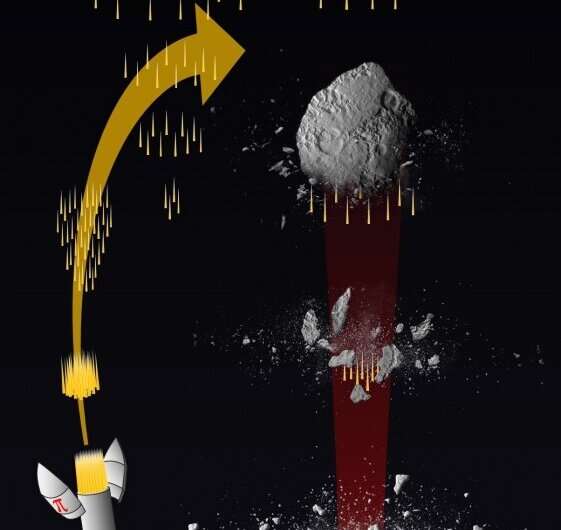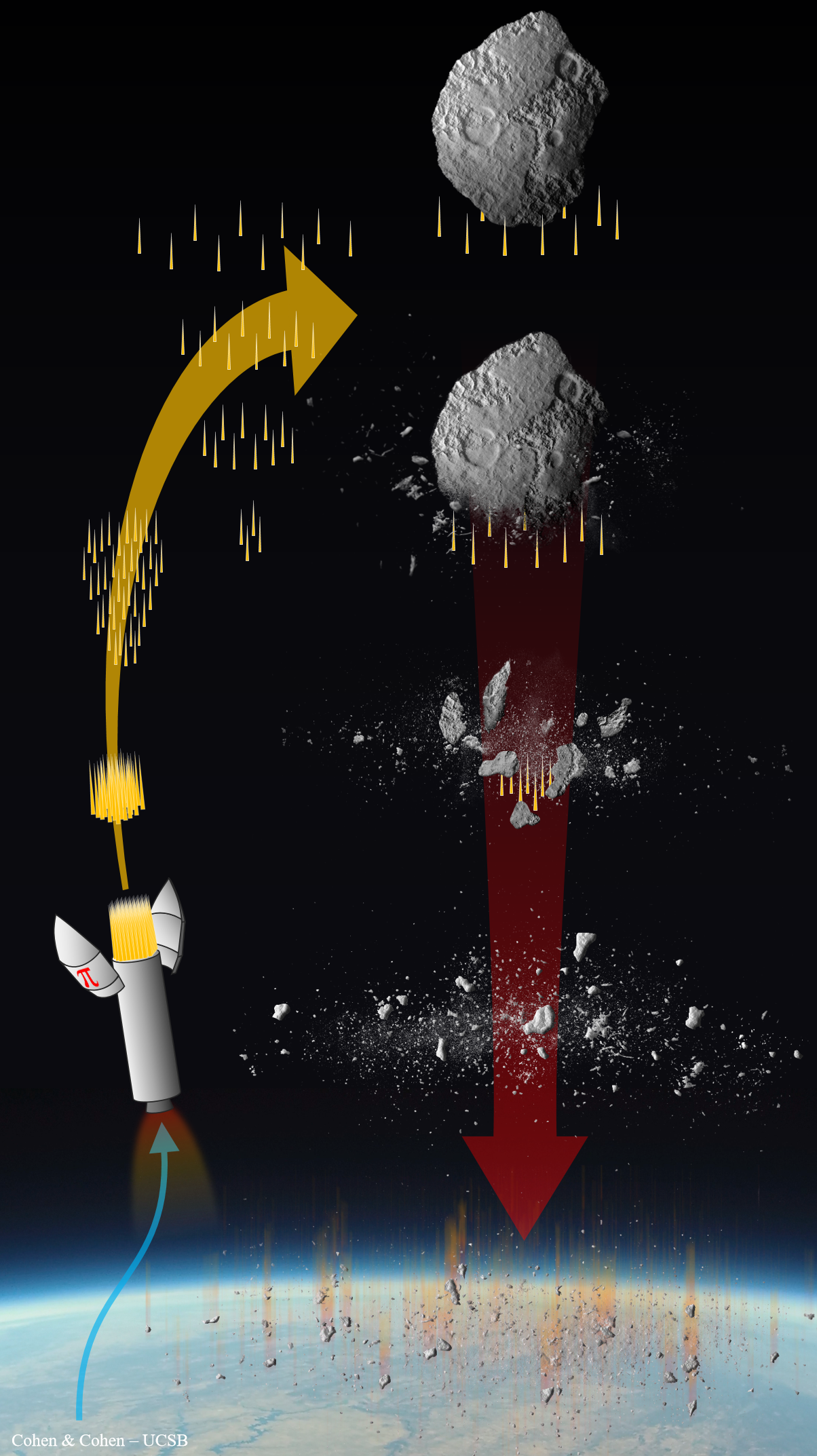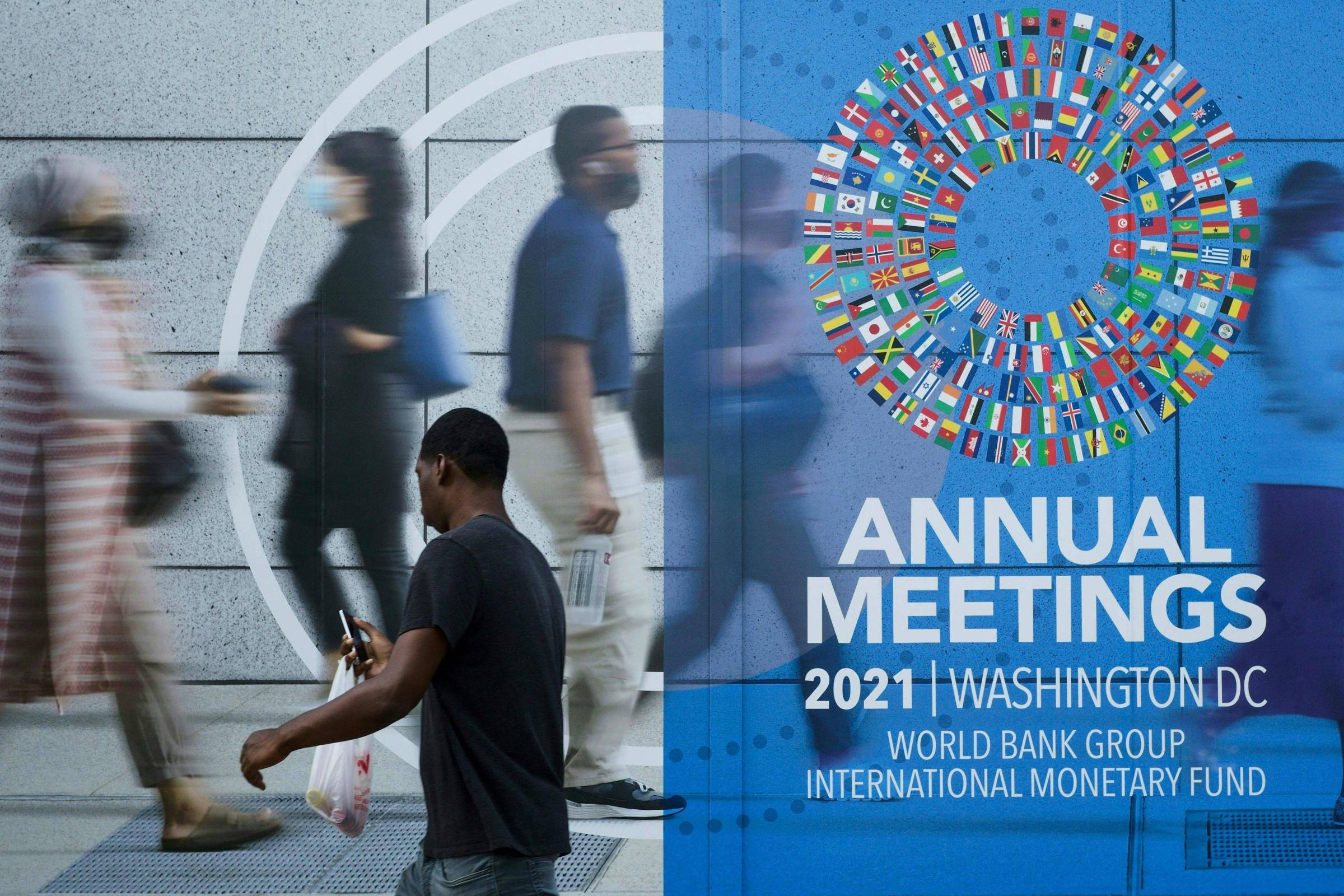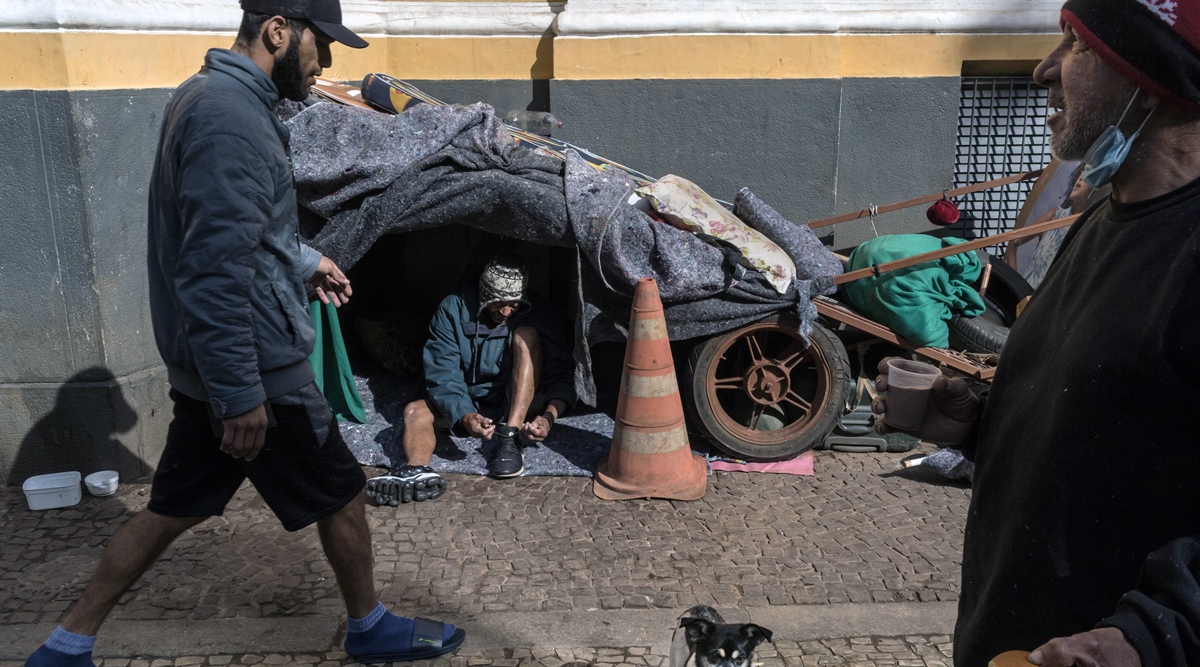Physicists propose a new method for defending the Earth against cosmic impacts

In February of 2013, skywatchers around the world turned their attention toward asteroid 2012 DA14, a cosmic rock about 150 feet (50 meters) in diameter that was going to fly closer to Earth than the spacecraft that bring us satellite TV.
Little did they realize as they prepared for the once-in-several-decades event that another bit of celestial debris was hurtling toward Earth, with a more direct heading. On Feb. 15, 2013, the Chelyabinsk meteor, a roughly 62-foot (19 meter)-diameter asteroid exploded over the city of Chelyabinsk, Russia, as it entered Earth's atmosphere at a shallow angle. The blast shattered windows and damaged buildings, and nearly two thousand people were hurt, though thankfully no one died.
"It turned out that two completely independent asteroids were coming by that day," said Philip Lubin, UC Santa Barbara professor of physics, and one of the many scientists anticipating 2012 DA14's near-Earth rendezvous. "One of them we knew was going to miss the Earth. The other one, we didn't even know it was coming."
For Lubin and scientists like him, incidents like these underline the importance of robust planetary defense—the detection, tracking, characterization and ultimately defense against potentially dangerous asteroids and comets. City-threatening events like Chelyabinsk are rare, happening about once every 50 to 100 years, but they are potentially devastating. The most recent of these occurrences was the Tunguska Event, an airburst over eastern Siberia in 1908, which flattened hundreds of square miles of forest. Rarer still, but nevertheless possible, are objects that threaten mass-extinction, such as the Chicxulub impactor, which wiped out the dinosaurs some 66 million years ago, or the more recent (12,800 years ago) airburst that caused widespread burning and the onset of an "impact winter" called the Younger Dryas.
However, one cannot discount the possibility of larger objects coming uncomfortably close to Earth in the near future: Apophis, with its 1,214-foot (370 meter) diameter, is due to make a close pass on Friday the 13th in April 2029, while Bennu, at 1,608 feet (490 m) in diameter, is expected to perform a similar pass in 2036. Though they are not anticipated to hit Earth, even relatively small changes in their orbit could cause them to enter gravitational pockets called "keyholes" that can place them on a more direct trajectory toward Earth.
"If it goes through the gravitational keyhole, it will generally hit Earth on the next round," Lubin said.
Strategies for planetary defense have progressed from research into better methods for understanding the threats, to efforts to deflect potential hazards and change their orbits, including a strategy developed by Lubin's group, which proposed the use of lasers to push threatening objects out of Earth's way.
In two papers on the topic of terminal planetary defense submitted to the journal Advances in Space Research, accompanied by an opinion piece published in Scientific American, Lubin and co-researcher Alexander Cohen lay out a more proactive method for dealing with dangerous extraterrestrial space debris. The project is called PI, which affectionately stands for Pulverize It.
Preparing for the inevitable: Do or do not?
"While we often say that nothing in life is certain but death and taxes, we can certainly also add human extinction to this list," Lubin said. "There is a large asteroid or comet lurking in our solar system with 'Earth' written on it. We just do not know where it is or when it will hit."
In the last 113 years, the Earth has been hit by two large asteroids that could have threatened the lives of millions, had they struck over a major city. However, humanity was lucky. In light of this very real threat, it is time to seriously plan for and execute a planetary defense program, the researchers say. PI allows for a logical and cost-effective approach to the ultimate environmental protection program.
Divide and conquer
Key to the PI strategy is the deployment of an array of penetrator rods, possibly filled with explosives, laid in the path of the asteroid to "slice and dice" the threatening object. The penetrator rods—about 4-12 inches (10-30 cm) in diameter and six to ten feet long—fragment the asteroid or comet nucleus as it crashes into them at extreme speed.
Crucially, instead of deflecting the object, the strategy is to let the Earth take the hit, the researchers said, but first to disassemble the asteroid into smaller pieces—typically the size of a house—and let the fragments enter the Earth's atmosphere. The atmosphere can then absorb the energy and further vaporize the house-sized pieces into small debris that do not hit the ground.
Since the original asteroid now enters the atmosphere as a large, distributed cloud of small fragments, they spatially and temporally distribute the energy of the impact, which de-correlates the blast waves created by each fragment. This vastly reduces the threat from catastrophic to more of a "fireworks display," complete with light and sound.
"If you can reduce the big events, which are dangerous, into a bunch of little events that are harmless, you've ultimately mitigated the threat," Cohen said.
"What's unique about this method is that you can have incredibly short response times," Lubin added. "A problem that other techniques like asteroid-deflecting methods have is that they are severely limited in their response times. In other words, they rely on getting an asset to deflect the threat all the way out to the asteroid long before it comes close to the Earth."
Instead, the PI "slice and dice" method intercepts asteroids or comets as they approach the Earth and could be deployed by launch vehicles that already exist today, such as SpaceX's Falcon 9 and NASA's SLS for larger targets. According to the physicists' calculations, smaller targets like the Chelyabinsk meteor could be intercepted just minutes before impact using much smaller launchers similar to ICBM interceptors, while targets that pose a more serious threat, like Apophis, could be intercepted just 10 days prior to impact. Mitigation times this short are entirely unprecedented, according to the researchers.
The best defense is a good offense
Another part of the program is to consider a proactive approach to protecting our planet, the researchers said.
"Much as we get vaccinated to prevent future diseases, as we are now so painfully aware, we could vaccinate the planet by using the penetrator arrays like the needles of a vaccine shot to prevent a catastrophic loss of life in the future," Lubin said.
In this approach, the same system can be used to proactively eliminate threatening objects like Apophis and Bennu to protect future generations.
"It is not well appreciated that large and threatening objects like the Apophis and Bennu asteroids are extremely serious," he continued. "Should they strike, each of them has an energy at impact equal to all of the nuclear weapons on Earth combined. Imagine all of the Earth's nuclear arsenal being detonated in a few seconds. With PI we can prevent this scenario."
This new approach, according to Lubin and Cohen, could make planetary defense quite feasible and "easy as PI," and would allow for a logical roadmap to a robust planetary defense system.
"Extraordinarily rapid response is possible," Lubin said. "We don't see any technological showstoppers. It's synergistic with the current generation of launch vehicles and others that are coming out." Additionally, Lubin added, the method "would be in great synergy with future lunar operations," with the moon potentially acting as a "forward base of operations."
"Humanity could finally control its fate and prevent a future mass extinction like that of the previous tenants of the Earth who did not bother with planetary defense, the dinosaurs."
You Can Blow Up an Asteroid Just a few Months Before it Hits Earth and Prevent 99% of the Damage
So far, the battle between life on Earth and asteroids has been completely one-sided. But not for long. Soon, we’ll have the capability to deter asteroids from undesirable encounters with Earth. And while conventional thinking has said that the further away the better when it comes to intercepting one, we can’t assume we’ll always have enough advance warning.
A new study says we might be able to safely destroy potentially dangerous rocky interlopers, even when they get closer to Earth than we’d like.
Humanity faces a dilemma regarding asteroids. We’ve identified many of the potentially dangerous ones, but not all of them, especially smaller ones. We know there must be undetected small asteroids out there, and they can still cause a lot of damage. An asteroid’s potential damage is due not just to its size, but also its angle of impact, its velocity, and its density. (Check out Purdue University’s asteroid impact simulator.) As a general rule of thumb, an asteroid the size of a football field could wipe out a city like New York.
NASA and other space agencies are concerned when it comes to Near-Earth Objects (NEOs) and Potentially Hazardous Objects (PHOs). The US Congress gave NASA a mandate to identify and catalogue 90% of NEOs 140 meters (460 ft) in diameter or larger. Sometime in 2026, NASA plans to launch the NEO Surveyor mission to find more asteroids in our neighbourhood. But it’s doubtful we’ll ever have a complete picture of all the asteroids that could do us harm. The Universe is full of surprises.

The preferred method of dealing with an asteroid headed for Earth is to deflect it as one chunk using a non-explosive kinetic impactor. But we need advance warning of the asteroid’s approach to do that. If we know decades ahead of time that an asteroid is on an Earth-impacting trajectory, then we need only launch a low-mass impactor. But what if an asteroid is heading straight for Earth and we don’t have enough lead-up time? What if we have less than one year until impact?
We’ll have to blow the thing up best we can and hope that the fragments don’t strike Earth.
But blowing an asteroid up as it’s approaching Earth is a risky maneuver. The asteroid could split into a dangerous swarm of fragments. There’s also a host of technical risks. Attaching an explosive nuclear device to a rocket and launching it into space is not without risks.
A team of researchers has published a study that delves into the issue. It’s titled “Late-time small body disruptions for planetary defence” and it’s published in the journal Acta Astronautica. The lead author is Patrick King from Johns Hopkins University Applied Physics Laboratory. In the study, the term “late-time” refers to less than one year from impact.
Blowing up an asteroid might not be that difficult, in some ways. In this study, the authors wanted to focus on what happens after one is blown up. What happens to all the fragments? “Our focus is on following to a high degree of accuracy the orbits of the fragments following the disruption of a hazardous body on an Earth-impact trajectory, and if they result in any Earth impacts, estimate the scale of the consequences,” they write. This is particularly important since so many asteroids are of the “rubble-pile” type, and only loosely held together.
The study simulated a 100-meter asteroid approaching Earth and then being disrupted with a one-megaton explosive device. The explosive device wouldn’t actually strike the asteroid, it would be detonated a few meters above the surface. A detonation like that doesn’t make the asteroid disappear; it just breaks it into smaller pieces, which should pose less of a threat if all goes well.

They also simulated five different impact scenarios based on five real-world asteroids. They chose Apophis and Bennu because both of those asteroids are so well-studied. The team chose 343158 Marsyas because it has a retrograde orbit and has a very high relative velocity, and also passed within 0.5 AU of Earth, making it an interesting and extreme scenario. They chose 5496 1973 NA (a minor planet) because of its highly inclined orbit, and because it passed within 0.08 AU in 1973. They also used PDC 2019, the hypothetical asteroid used in the 2019 Planetary Defence Conference.

The simulation’s outcome is promising.
“One of the challenges in assessing disruption is that you need to model all of the fragment orbits, which is generally far more complicated than modelling a simple deflection,” lead author King said in a press release. “Nevertheless, we need to try to tackle these challenges if we want to assess disruption as a possible strategy.”
The team simulated the 100-meter asteroid in five different scenarios. In all five scenarios, the disrupting device was detonated when the asteroid was two months away from Earth. Also in all five, 99.9% of the asteroid’s mass missed Earth.

This study doesn’t change the fact that kinetic impacts are preferred when it comes to asteroid deflection. The further away an asteroid is when it’s detected, the better. A smaller kinetic impactor is enough. But this study is aimed at late-time small bodies. There isn’t enough time to launch a kinetic impactor with enough mass if we don’t have enough lead time.
But it does show that nuclear devices can be part of humanity’s arsenal in the struggle against asteroids.
“We focused on studying ‘late’ disruptions, meaning that the impacting body is broken apart shortly before it impacts,” he said. “When you have plenty of time — typically decade-long timescales — it is generally preferred that kinetic impactors are used to deflect the impacting body.”
But this study is focused on late disruptions, situations where we don’t have enough time to send an impactor. It’s important that we understand the ramifications of shattering an approaching asteroid into pieces. To help them understand all this, study co-author Michael Owen wrote a piece of software called Spheral. Spheral was able to model not only the nuclear disruption of the asteroid but also all of the resulting fragments.
After the explosion, the fragments were subject to each others’ gravity and the gravity of the Earth, Moon, and Sun. The team found that the fragments formed a coherent stream in space.
“If we spotted a hazardous object destined to strike the Earth too late to safely divert it, our best remaining option would be to break it up so thoroughly the resulting fragments would largely miss the Earth,” Owen said. “This is a complicated orbital question though — if you break up an asteroid into pieces, the resulting cloud of fragments will each pursue their own path around the sun, interacting with each other and the planets gravitationally. That cloud will tend to stretch out into a curved stream of fragments around the original path the asteroid was on. How quickly those pieces spread out (combined with how long until the cloud crosses Earth’s path) tells us how many will strike the Earth.”
NASA is about test the kinetic impactor method of asteroid protection with its Double Asteroid Redirection Test (DART) mission. Its launch is scheduled for November 24th, 2021.
The “Double” in the name refers to the double asteroid Didymos. Didymos is about 780 meters in diameter, but it has a little companion named Didymoon. Didymoon is DART’s target, and it’s only about 160 meters in diameter. Most of the asteroids that pose a threat are a similar size to Didymoon. The DART spacecraft itself is the kinetic impactor, and it’ll be sent to collide with Didymoon while sensitive telescopes watch and see what happens.

But there’s no real way to test a nuclear detonator on an asteroid. Maybe in the future, we could test one on an asteroid approaching another planet. The sci-fi-minded can easily envision that. But real-world testing on an asteroid anywhere in Earth’s vicinity is a bad idea. Too many things could go wrong. People would never accept it.
For now, we have to rely on simulations like the ones in this study, and future studies that build on this one and refine it.
“Our group continues to refine our modelling approaches for nuclear deflection and disruption, including ongoing improvements to X-ray energy deposition modelling, which sets the initial blowoff and shock conditions for a nuclear disruption problem,” said co-author Bruck Syal. “This latest paper is an important step in demonstrating how our modern multiphysics tools can be used to simulate this problem over multiple relevant physics regimes and timescales.”
More:
A new approach could mitigate the most damaging effects of an imminent asteroid or comet strike—or ensure many threatening objects never get close to striking Earth in the first place
October 13, 2021

Less than eight years from now, on Friday the 13th of April 2029, a 370-meter-wide asteroid called Apophis will pass by the Earth, coming nearer to our planet than geosynchronous satellites. But despite the calendrical bad omen, this will be a lucky day: Apophis will not strike our planet—this time, anyway (its orbit ensures Apophis will visit us again in 2036, 2051, 2066 and so on). In 2029, this asteroid’s passage will instead be a cosmic close shave, the equivalent of a speeding bullet brushing against the hairs on your head—in which the “bullet” carries the equivalent impact energy of all the world’s nuclear arsenals combined.
Such dangerous liaisons are shockingly frequent. On September 30, 2054 and September 23, 2060, an even larger asteroid packing an even more potent wallop, the half-kilometer-wide Bennu that was recently visited by NASA’s OSIRIS-REx spacecraft, will also swoop close to Earth.
Neither Bennu nor Apophis are large enough to be existential threats—their impacts could destroy cities and devastate geographical regions but would not send humanity spiraling into extinction like the 10-kilometer-wide impactor that snuffed out the dinosaurs some 66 million years ago. Still, these asteroids remain especially worrisome because the further into the future we look, the harder it becomes to know with certainty whether or not any particular encounter will result in a disastrous impact event. Both objects are so-called “gravitational keyhole” threats—the possibility that during a close pass they will traverse a small, specific region of near-Earth space in which our planet’s gravity tweaks their trajectories just so to cause a future encounter to end in an Earth impact. In short, they each pose a chronic-but-hazy threat, one so insidious that it could lull us into a state of false complacency about the all-too-real risks.
We do not have to accept this anxiety-inducing status quo. Rather than merely biting our nails each time these and other potentially hazardous space rocks fly by, we should consider another option, a “plan B.”
A LAST LINE OF DEFENSE
Our current approach to planetary defense boils down to wishful thinking that nothing bad will happen soon and that we will eventually figure out a solution. So far, we have been focused on “situational awareness” in order to understand the threats. This is necessary but not sufficient for actually protecting the Earth from asteroids. And the standard next step—deflecting potential threats so they will not hit us—has problems of its own, chiefly that successful deflection often requires intervention many years in advance. In this mode, many space rocks found hurtling toward imminent impact with Earth would already have slipped through all our defenses. There is, however, another way, one that promises to radically change our ability to protect ourselves.
The basic principle is simple to understand. Imagine you are Roger Rabbit playing a dangerous game of chance, choosing between two unopened doors. Behind door number one you get a 500-kilogram grand piano being dropped on your head from a height of one kilometer. Behind door number two you get 500 kilograms of foam balls dropped on you from the same height. Which do you choose? If you are Roger you might choose door number one, but a Scientific American reader would choose door number two. Why? Both possess the same mass and potential energy, but basic intuition suggests that large numbers of foam balls will not cause the same damage to you as one piano. Fragmenting the mass into smaller portions ensures that each will carry far less energy, and will also allow the atmosphere to more effectively slow each fragment’s fall. This is a rather precise analogy to our proposed planetary-defense method, which we affectionately call “PI” (pronounced like π), which is short for “Pulverize It!”

Our idea (which is detailed in several technical papers submitted for peer-reviewed publication and available on our Web site and arXix) is to effectively pulverize any threatening asteroid into a large number of smaller fragments circa 10 meters or less in diameter. This is possible because asteroids have low surface gravity and most are easy to breakup and disperse. For all but the largest impactors (greater than a kilometer wide), such fragmentation could be achieved using barrages of nonnuclear interceptors launched from Earth or its vicinity using existing launch systems and associated technologies. Our same system using small nuclear penetrators is also an option for large threats.
Once fragmented, the incoming impactor’s energy would be efficiently converted into heat, sound and light by the Earth’s atmosphere, which would act much like a bulletproof vest absorbing a blast of buckshot. Our analysis shows this approach works incredibly well at mitigating imminent threats: An impactor the size of the 20-meter-wide space rock that broke up over Chelyabinsk, Russia in February 2013 could be intercepted a mere 100 seconds prior to impact, whereas one the size of the Tunguska impactor (50 meters in diameter) would require interception some five hours prior to impact. Something the size of Apophis could be dealt with 10 days prior to striking Earth, and something as large as Bennu would need to be fragmented 20 days in advance. These are extraordinarily short intercept times compared to deflection approaches. Even shorter times would be enabled with more energetic interceptors if required.
Of course, a knowledgeable reader may realize we have not told the entire story. Both the previously mentioned Chelyabinsk and Tunguska impacts were airburst events, after all, and in both cases surrounding natural and artificial structures sustained significant damage. This damage chiefly came from the sonic-boom-like acoustic blast waves emitted by the bodies as they broke apart in the atmosphere.
Our PI approach would not eliminate airbursts, but by shattering incoming bodies before they enter the atmosphere the resulting small fragments would be spread out over larger geographical areas and would each produce much smaller blast waves and critically that arrive at different times. Just as you’d expect to have bruising and soreness from a bulletproof vest absorbing a buckshot blast, so too would one expect some damage to still occur on the ground from the acoustic shock wave and associated flash of light and heat as a threatening asteroid’s tumbling fragments burned up in the skies overhead. But this damage would be slight in comparison to the alternative; for a Chelyabinsk-like impactor, a person on the ground would experience a series of loud “booms” and see a series of optical flashes—a “sound and light show” with some broken windows, rather than a cataclysm that lays waste to a city, region or country.
DEMONSTRATIONS AND DETECTIONS
Despite our system’s ability to leverage existing technologies and launch vehicles, its creation would nevertheless require major investments. In short, this would be expensive. But even so, the cost-benefit ratio is remarkably favorable given the almost incalculable damage that would be associated with failing to prevent an asteroid strike.
Furthermore, its creation would allow us more flexibility in dealing with known impact threats, now and on into the distant future. Much as mass vaccination programs are used to proactively prevent against pandemics, PI offers a way to proactively address many asteroids that, while potentially hazardous in their Earth-crossing orbits, pose no immediate threat. While likely a controversial approach, it is little different from other proactive threat management we practice in life. We could mitigate threats such as Apophis and Bennu on any given close pass before they spark full-blown emergencies. It is within our power to do so. Whether we do so or not is not just a technical issue but one of policy and cooperation and common agreement. This is an area where international cooperation could benefit the entire planet; much like the current emphasis on collectively solving Earth’s climate and pandemic crisis, we come together to solve the “impact” crisis, too.
Mitigating a Chelyabinsk-size threat could be done using a relatively small rocket that is not much larger than those developed to intercept intercontinental ballistic missiles. Mitigating Apophis or Bennu can be done with a single larger launcher such as NASA’s forthcoming Space Launch System, SpaceX’s Starship rocket, or even smaller vehicles carrying high-speed upper stages for rapid transit beyond the vicinity of Earth’s moon. Multiple interceptors would be desirable to boost chances of success. A future planetary defense system might deploy interceptors in orbit or on or around the moon for an “always at the ready” rapid response approach. In this sense a planetary defense system could be analogous to existing national missile defense systems.
PI has a logical test path, from ground demonstrations using asteroid “mock-ups,” to in-space testing on “synthetic targets,” all the way to disruption attempts for small, minimally threatening asteroids and other validating exercises before any actually threatening target is engaged and mitigated.
However, we cannot mitigate that which we cannot see. NASA and other space agencies are doing an excellent job of finding and tracking those asteroids that are significant threats, but currently these efforts are generally limited to objects typically larger than Apophis. There are many smaller as-yet-undetected threats that exist, as the Chelyabinsk airburst showed so clearly in 2013. Without a suitable, separately developed “early warning system,” PI and any other planetary defense method would offer suboptimal protection. PI is just one piece of this urgent puzzle: To properly protect the Earth, we must fully open more eyes on the skies.
For more information: www.deepspace.ucsb.edu/projects/pi-terminal-planetary-defense.
Philip Lubin is a professor of Physics at UC Santa Barbara whose primary research has been focused on studies of the early universe as well as applications of directed energy for planetary defense and relativistic propulsion.
Alexander Cohen is a research scientist in the Department of Physics at UC Santa Barbara. Having graduated with a B.S. in physics in 2019, Cohen now researches applications of directed energy, primarily for spacecraft propulsion and planetary defense from asteroids.










